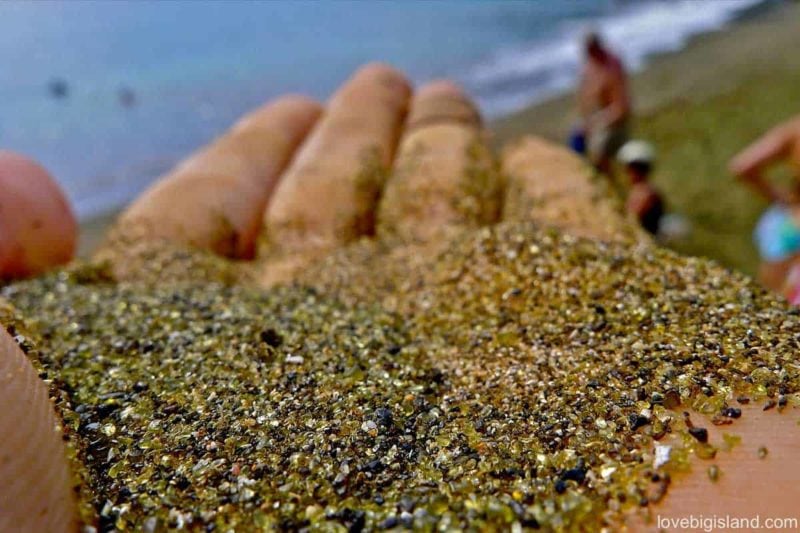Green sand beach gets its name from the green olivine crystals that make up the sand. The crystals come from the cinder cone next to the beach which was formed during an eruption 49.000 years ago. If you are thinking about visiting while on the Big Island you should have a look at our article on visiting green sand beach.
This green sand beach trivia article will teach you:
Table of contents
- The how and why of the 3 different names this beach is known for
- Why is green sand, green? (olivines!)
- How many green sand beaches are there? (+ information on chemical composition and crystal-to-sand ratio).
Table of Contents
- The how and why of the 3 different names this beach is known for
- Why is green sand, green? (olivines!)
- How many green sand beaches are there? (+ information on chemical composition and crystal-to-sand ratio).
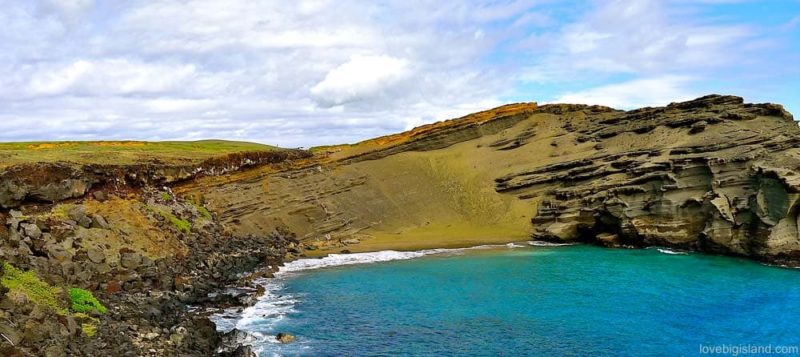
Green Sand Beach. One of the two green sand beaches in the United States. Close to the south point of the island
The different names of green sand beach
Green sand beach is officially named “Papakōlea Beach”, but is also known as Mahana Beach and of course as (drum roll…) green sand beach!
These names have the following background:
Papakōlea Beach:
This name is a contraction of the words papa and kōlea. Papa means ‘flats’ and kōlea is the Hawaiian name for the Pacific golden plover. These birds can be found in this area during the winter, hence the name “Plover flats”.
Mahana Beach:
The cinder cone next to the beach is called the Puʻu Mahana. The green sand grains on the beach are actually small olivine crystals that formed during an eruption of the Mauna Loa volcano about 49.000 years ago!
Green Sand Beach:
This name is pretty self-explanatory and is the most commonly used name for this beach on the Big Island in tourist guides. Read on to find out why exactly the sand is green at green sand beach.
Why is the sand at green sand beach, green?
Green Sand Beach gets its name from the green glassy crystals (Olivine) that make up most of the sand on this beach. Olivine is locally known as “Hawaiian Diamond” and is denser and tougher than the ash fragments, glass and black pyroxene that make up the rest of the volcanic material at the beach.
The secret of Green Sand Beach is the unique combination of a 49.000-year-old cinder cone that spewed olivine-rich lava and a bay that keeps the olivine crystals that are washed out of the rocks trapped. Olivine is relatively heavy and tends to accumulate on the beach, whereas the lighter volcanic sand is swept out to sea. How green the beach looks is a direct reflection of the ratio between the green olivine and the other sand-components.
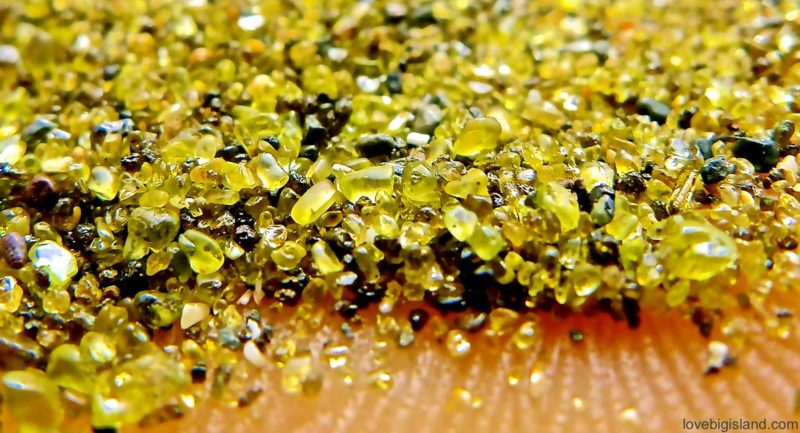
Green sand containing olivine crystals, small pieces of lava and shell fragments from Papakolea beach (green sand beach) on the Big Island.
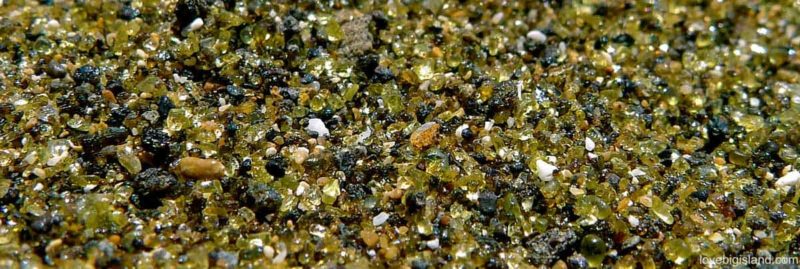
You can see that the sand of green sand beach exists of the green olivine crystals, black lava fragments and white pieces of sea shells.
How many green sand beaches are there in the world?
This question is actually pretty difficult to answer. If you go to Wikipedia, you will see that there are only 4 green sand beaches in the world:
- Talofofo Beach on Guam
- Punta Cormorant on Floreana Island in the Galapagos Islands
- Hornindalsvatnet in Norway
- Papakōlea beach on the Big Island of Hawai’i
But what exactly is a green sand beach?
Papakolea beach on the Big Island gets its color from a large amount of olivine crystals that are mixed into the sand, but there are many other beaches where the sand contains less olivine crystals and that thus are less green. To make things even more confusing there are also many beaches that have green sand for reasons other than olivine crystals!
What is the reason behind these many shades of green?
How “green” the sand on a beach is, depends on the two following factors:
- Chemical composition: Most green sand beaches have different shades of green, depending on the minerals that give them their color. Some examples of these ‘green’ minerals are: Glauconite, Malachite, Chlorite, Epidote, and Serpentine. You can find an illustrated article with photos of some of these beaches here.
- Amount of olivine: Olivine is a pretty common constituent of basalt (lava), and it can be found all over the Big Island and in many other volcanic regions in the world. You can for example easily find rocks with green olivine crystals in them when crossing the crater of the Kilauea’iki (one of our favorite short hikes on the Big Island) in the Hawaii Volcanoes National Park.
This means of course that there are also other “not as green” green sand beaches on the Big Island (and worldwide), such as Richardsons ocean park in Hilo. You can find some green sand (olivines) on these beaches, but not in the amount one can find for example on Papakōlea beach.
What makes Papakōlea beach so special is that its sand contains so many olivine crystals. Because of its unique location in a narrow bay, the lighter sand particles wash away out to the ocean but the heavier olivines remain behind on the beach.
In summary, there are many shades of green when talking about green sand beaches and to say there are “only four green sand beaches on the planet” is cutting a lot of corners. Having said that, Papakōlea beach on the Big Island is a unique beach with sand that has one of the highest olivine contents of the world! It’s safe to say that the Big Island is an amazing place :)
Our favorite white sand, black sand and green sand beach on the Big Island:
You can find out why white sand is white and why black sand is black at our hottest big island beaches article. In it we describe our #1 picks for beaches with sand that is green, black and white.
Green sand beach (Papakōlea)
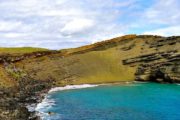
![Green Sand Beach [trivia]](https://www.lovebigisland.com/wp-content/uploads/olivines.jpg)
